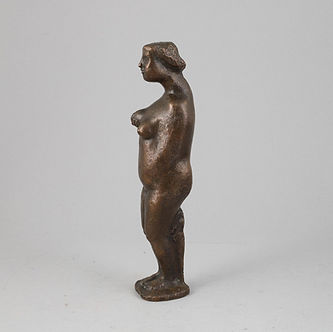
Bror Marklund|1907-1977
Bror Marklund became an orphan early on, and was trained as a carpenter in Umeå. In 1926 he became an ornamental sculptor in Stockholm, and in 1928 a student of Carl Milles and Nils Sjögren at the Art Academy, where he was influenced by Aristide Maillol and Despiaus.
Between 1934 and 1936 he traveled in Italy and France as a scholar. In Paris he drew at the Maison Watteau and the Académie Colarossi. Modernism had reached considerably further in France and Brother Marklund was particularly impressed by Ossip Zadkine and Henri Laurens. Others who left traces in his art were Pablo Picasso and Henry Moore.
His art has been described as eroticistic primitivism, raw pagan style mixed with medieval features, and with brutality, antiquity and the monumental as a recurring theme. He himself said: "To make a beautiful grunka, it just never
happened".
Bror Marklund's first studio was at Tungelsta, the second was the church hall above Ungkarlshotellet Glasbruket på Söder in Stockholm, which in the 18th century was a home for fallen women. For a period he rented the chapel at Överjärva gård gård as a studio. He also had a studio in Funäsdalen in Härjedalen, where he enjoyed himself best. In July 1938, the Historical Museum announced a competition for bronze gates for its building.
Marklund won the competition against over 42 competitors, and thus became one of the most famous artists of his time. The gates have the motto "Inheritance of the Fathers", and are inspired by Jan Fridegård's novel Land of the Gods (1940), Picasso's Guernica, Indian art and the 11th century Frog statuette. Some of the main motifs of the gates are a pregnant woman, Odin, and Ansgar. In 1959,
Marklund succeeded Bror Hjorth as professor of drawing at the Academy of Arts, and became a member of the Academy of Arts in 1953.
Awards Marklund received several awards during his lifetime, among others the King's Medal and the Sergel Prize. His summer studio in Funäsdalen was donated to Örnsköldsvik municipality after his death. It was then moved, and placed at Örnsköldsvik's museum and art hall. The municipality of Örnsköldsvik has established a scholarship in his memory.
Public works in selection
Sitting Boy (1936), bronze, outside Norrköping Art Museum, Odenplan in Stockholm and at the square in Västertorp, Stockholm
Bathing youth (1937), bronze, Varberg square (fountain)
The gates of history (1939-1952), bronze gates to the facade of the History Museum, Stockholm, as well as a bronze relief above (1959) and four iron facade sculptures (1960)
Thalia (1944), bronze (formerly plaster), the foyer of Malmö Stadsteater
The refugee monument in Sibbarp in Malmö (1950), granite
Woman (1950-1953), Ekeberg marble, Norrköping Art Museum
Mother and Child (1956), bronze, courtyard of the Kanslihuset at Mynttorget, Stockholm
SE bank headquarters, Sergels Torg, Stockholm
Gestalt i storm (1972), bronze, at the Swedish Embassy in Moscow
Marklund also did the scenography for August Strindberg's Master Olof, staged under Alf Sjöberg's direction at the Dramatiska teatern in Stockholm in 1972.
Marklund is represented at, among others, the National Museum[6] and the Modern Museum in Stockholm and the Archive for Decorative Arts
